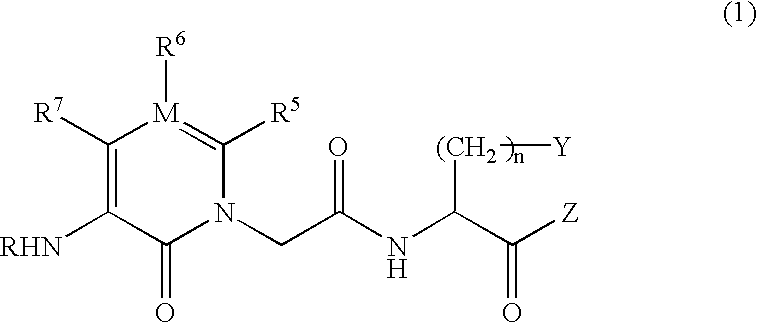IgE antibody production inhibitors and autoimmune diseases inhibitors
a technology of autoimmune diseases and production inhibitors, which is applied in the direction of immunological disorders, drug compositions, peptide/protein ingredients, etc., can solve the problems of autoimmune diseases that have not been made clear, autoantibodies appearing in the blood, and inappropriate class ii antigen expression, etc., to achieve a high chymase inhibitory action, no suppressive action, and feeble histamine release suppressive
- Summary
- Abstract
- Description
- Claims
- Application Information
AI Technical Summary
Benefits of technology
Problems solved by technology
Method used
Image
Examples
reference example 2
Synthesis of 2-amino-1-hydroxy-1-[5-(methoxy-carbonyl)benzoxazol-2-yl]-3-phenylpropane
Step (1): To a solution of 4-hydroxy-3-nitrobenzoic acid (15.8 g, 86.3 mmol) in 1,2-dichloroethane (150 ml) were added methanol (14 ml) and concentrated sulfuric acid (0.5 ml), and the mixture was stirred under heating at 80.degree. C. In the course, methanol (9 ml) was added and the mixture was stirred for 21 hours. This reaction mixture was added to saturated sodium hydrogencarbonate aqueous solution (400 ml) and extracted with chloroform. The extract was washed with saturated brine, dried over magnesium sulfate, and concentrated under reduced pressure to give 11.5 g (yield 68%) of the objective compound methyl 4-hydroxy-3-nitrobenzoate as a yellow solid.
Step (2): To a solution of the objective compound of step (1) (11.4 g, 57.8 mmol) in ethyl acetate (300 ml) was added 10% palladium-carbon (1.80 g) under a nitrogen atmosphere, and the mixture was stirred under a hydrogen atmosphere at room tempe...
reference example 3
Synthesis of 2-amino-1-hydroxy-1-[5-(methoxy-carbonyl)benzoxazol-2-yl]-3-phenylpropane
Step (1): To a solution of 4-hydroxy-3-nitrobenzoic acid (15.8 g, 86.3 mmol) in 1,2-dichloroethane (150 ml) were added methanol (14 ml) and concentrated sulfuric acid (0.5 ml), and the mixture was stirred under heating at 80.degree. C. In the course, methanol (9 ml) was added and the mixture was stirred for 21 hours. This reaction mixture was added to saturated sodium hydrogencarbonate aqueous solution (400 ml) and extracted with chloroform. The extract was washed with saturated brine, dried over magnesium sulfate, and concentrated under reduced pressure to give 11.5 g (yield 68%) of the objective compound methyl 4-hydroxy-3-nitrobenzoate as a yellow solid.
Step (2): To a solution of the objective compound of step (1) (11.4 g, 57.8 mmol) in ethyl acetate (300 ml) was added 10% palladium-carbon (1.80 g) under a nitrogen atmosphere, and the mixture was stirred under a hydrogen atmosphere at room tempe...
example 1
Synthesis of 2-[5-amino-2-(4-fluorophenyl)-6-oxo-1,6-dihydro-1-pyrimidinyl]-N-[1-[[5-(methoxy-carbonyl)benzoxazol-2-yl]carbonyl]-2-phenylethyl]acetamide (Compound 1)
Step (1): The [5-benzyloxycarbonylamino-2-(4-fluorophenyl)-6-oxo-1,6-dihydro-1-pyrimidinyl]acetic acid (1.30 g, 3.27 mmol) obtained in Reference Example 1 and the 2-amino-1-hydroxy-1-[5-(methoxycarbonyl)benzoxazol-2-yl]-3-phenylpropane (1.08 g, 3.31 mmol) obtained in Reference Example 2 were dissolved in DMF (10 ml), followed by addition of HOBT (884 mg, 6.54 mmol) and WSCI hydrochloride (752 mg, 3.92 mmol), and the mixture was stirred at room temperature for 4.5 hours. This reaction mixture was added to 0.5 N-hydrochloric acid (80 ml) and extracted with ethyl acetate. The precipitated solid was collected by filtration and dried in vacuo to give 1.26 g of 2-[5-benzyloxycarbonylamino-2-(4-fluorophenyl)-6-oxo-1,6-dihydro-1-pyrimidinyl]-N-[1-[[5-(methoxycarbonyl)benzoxazol-2-yl]hydroxymethyl]-2-phenylethyl]acetamide as a wh...
PUM
| Property | Measurement | Unit |
|---|---|---|
| Volume | aaaaa | aaaaa |
| Mass | aaaaa | aaaaa |
| Mass | aaaaa | aaaaa |
Abstract
Description
Claims
Application Information
 Login to View More
Login to View More - R&D
- Intellectual Property
- Life Sciences
- Materials
- Tech Scout
- Unparalleled Data Quality
- Higher Quality Content
- 60% Fewer Hallucinations
Browse by: Latest US Patents, China's latest patents, Technical Efficacy Thesaurus, Application Domain, Technology Topic, Popular Technical Reports.
© 2025 PatSnap. All rights reserved.Legal|Privacy policy|Modern Slavery Act Transparency Statement|Sitemap|About US| Contact US: help@patsnap.com



